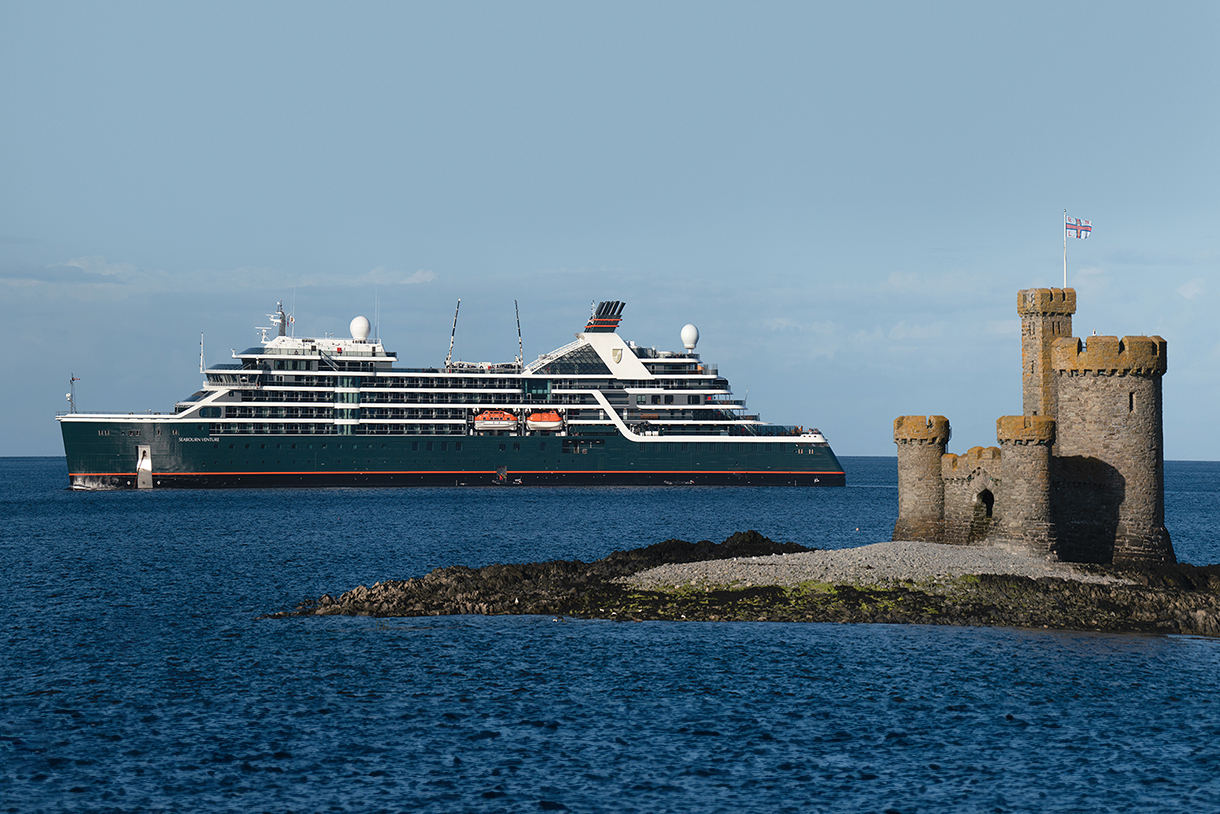
Seabourn Venture, Isle of Man
Travel
Sailing Celtic Seas on Seabourn Venture
by Frank Vizard
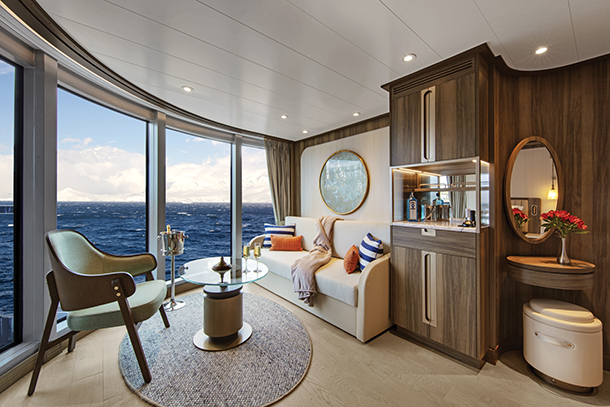

Ireland and Scotland may not be the most exotic of destinations, but a voyage around the seas between and around the two countries offers a Celtic point of view not so easily found with a land-bound perspective. Whether it’s appreciated from the expedition ship’s deck or experienced from a sea-level vantage point aboard a rubber Zodiac, a 14-day Lands of the Celts odyssey aboard the Seabourn Venture (seabourn.com) is a looking glass into the Celtic culture that links the different shores. Sometimes those connections find expression in a glass of a different sort, imbibed along the way with a wistful Celtic eye toward what might have been and what yet may be. These are islands of a sometimes-contradictory duality where seeing clearly is one thing and where not seeing may be just as well.
Simply put, the Seabourn Venture is a five-star hotel at sea with top-notch restaurants included. Compared to other cruise ship behemoths, the green-hulled Seabourn Venture is deliberately small, being the company’s first purpose-built expedition ship with room for 264 passengers housed in 132 veranda-equipped luxury suites for constant sea views. The idea is to go places larger ships can’t—that the hull is rated as PC6 Polar Class indicates the ship’s ambitious intentions. With the exception of larger ports, expect to get on and off the ship via zippy Zodiac rubber boats. Also on board is a pair of mini submarines that puts underwater adventures on the agenda, although their use is limited by local regulations and conditions. (Currents in the Irish Sea, for example, are too strong and fast to allow for the deployment of the six-passenger submersibles.) A key attribute of every journey is a large expedition staff with impressive scientific credentials and a catching enthusiasm for the outdoors. The Venture launched in 2022 and a sister ship, the Pursuit, launched in 2023.
For its Land of the Celts voyage, the Seabourn Venture slips south out of London around the corner and along the bottom of old England. The familiar becomes remote among the Isles of Scilly, 28 miles beyond Land’s End. On Tresco (tresco.co.uk)—one of the five inhabited islands among the 145 scattered about and said to be the mountaintops of a long-lost submerged realm—is the remarkable Tresco Abbey Garden. The site is seemingly a repository of the world’s plants, thanks to a unique microclimate that hosts 20,000 plants. It’s also a haven for red squirrels at the losing end of a deadly feud with their brown squirrel cousins. Catching the maritime eye is the Valhalla Museum, with its collection of 30 figureheads recovered from shipwrecks that have sunk around the Isles of Scilly over the years. Navigation hereabouts is never a certainty.
Simply put, the Seabourn Venture is a five-star hotel at sea with top-notch restaurants included. Compared to other cruise ship behemoths, the green-hulled Seabourn Venture is deliberately small, being the company’s first purpose-built expedition ship with room for 264 passengers housed in 132 veranda-equipped luxury suites for constant sea views. The idea is to go places larger ships can’t—that the hull is rated as PC6 Polar Class indicates the ship’s ambitious intentions. With the exception of larger ports, expect to get on and off the ship via zippy Zodiac rubber boats. Also on board is a pair of mini submarines that puts underwater adventures on the agenda, although their use is limited by local regulations and conditions. (Currents in the Irish Sea, for example, are too strong and fast to allow for the deployment of the six-passenger submersibles.) A key attribute of every journey is a large expedition staff with impressive scientific credentials and a catching enthusiasm for the outdoors. The Venture launched in 2022 and a sister ship, the Pursuit, launched in 2023.
For its Land of the Celts voyage, the Seabourn Venture slips south out of London around the corner and along the bottom of old England. The familiar becomes remote among the Isles of Scilly, 28 miles beyond Land’s End. On Tresco (tresco.co.uk)—one of the five inhabited islands among the 145 scattered about and said to be the mountaintops of a long-lost submerged realm—is the remarkable Tresco Abbey Garden. The site is seemingly a repository of the world’s plants, thanks to a unique microclimate that hosts 20,000 plants. It’s also a haven for red squirrels at the losing end of a deadly feud with their brown squirrel cousins. Catching the maritime eye is the Valhalla Museum, with its collection of 30 figureheads recovered from shipwrecks that have sunk around the Isles of Scilly over the years. Navigation hereabouts is never a certainty.
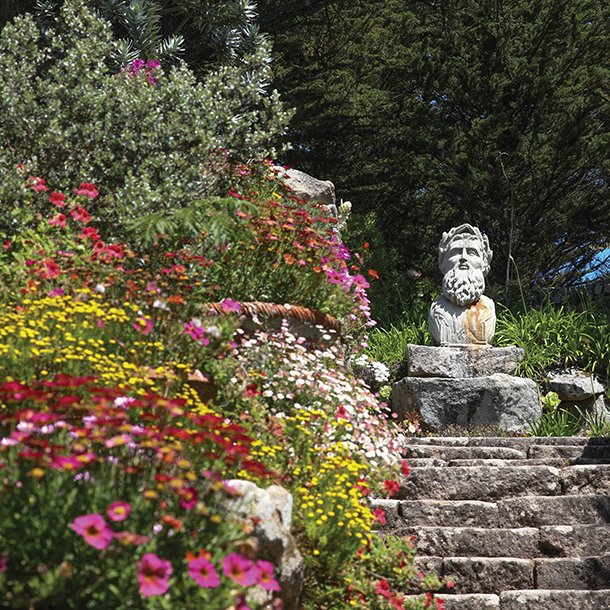
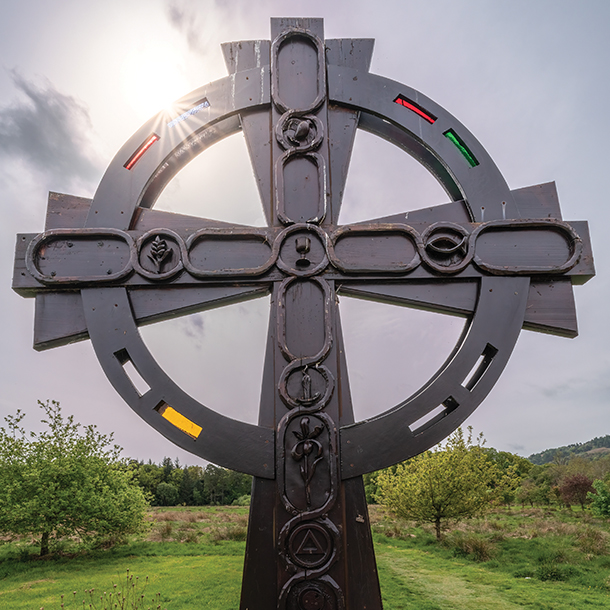
With the exception of Tresco, the Isles of Scilly are Crown lands belonging to the Duchy of Cornwall and thence to the ultimate landlord king of England. Beyond the Isles of Scilly, heading north past highly trafficked Celtic Wales into the heart of the Irish Sea, are lands where the ruler of longer reverence is Manannán mac Lir, an ancient Celtic sea god for whom it’s often said the Isle of Man is named. He’s considered a prankster and the joke is on Zodiac tourers who spy puffins on the cliffs of the Calf of Man, a small nearby island, only to realize they’re fakes meant to lure real ones into nesting. (Only the humans are fooled.) The Isle of Man is a self-governing dependency of the British Crown with an eye-catching triskelion flag featuring three connected armored legs on a red background (their motto: “Whithersoever you throw it, it shall stand.”) that dates to the 13th century when Manx rule included islands to the north. The Manx Museum (manxnationalheritage.im) in the capital of Douglas presents an informative display of the island’s Viking and Celtic (Gaelic) history as well as the story behind the tailless Manx cat. The local beer is good as well, best enjoyed after a long walk along the seaside promenade.
A daylong landing in Dublin in the Republic of Ireland is a visit to the capitol of Celtic aspirations that vary in amplitude according to surrounding currents. A key tour on offer is a visit to the Museum of Irish Literature (moli.ie), where the 1922, Aegean-blue first edition of Ulysses by author James Joyce, regarded now as perhaps the most influential writer of the 20th century, is accorded a reverence usually reserved for inspirational texts like the Bible. (Ulysses follows the structure of Homer’s Greek sea epic, The Odyssey.) The flavor of Joyce’s novel also can be captured at the nearby Davy Byrnes pub (davybyrnes.com) that still features the gorgonzola sandwich mentioned in Ulysses and can be consumed with a glass of Burgundy (according to the text) or with a more local option such as a creamy-thick, black pint of Guinness. Either way, the last line of the book may be rapturously borrowed in a new context: “Yes I said yes I will Yes.”
From Dublin, the Seabourn Venture glides up through the narrow North Channel out of the Irish Sea to the city of Glasgow on the western shores of Scotland, another great manifestation of Celtic culture. Ship visits are necessarily brief, so each stop is like a morsel consumed from a large Gaelic tray of delicacies. The Kelvingrove Art Gallery and Museum (glasgowlife.org.uk) in Glasgow is a marvelous, castle-sized cabinet of curios whose cleverly chaotic collection includes a bust of William Wallace of Braveheart fame vying for attention with a life-sized stuffed elephant closely overflown by a Spitfire fighter from World War II. In some respects, the holdings of Kelvingrove reflect the Celts themselves. This diverse group of people encompass a fluid, shifting identity that often focuses on the value of individual objects produced locally over a broader, structured aesthetic that nonetheless floats faintly, tangibly, and recognizably through Celtic time and space.
A daylong landing in Dublin in the Republic of Ireland is a visit to the capitol of Celtic aspirations that vary in amplitude according to surrounding currents. A key tour on offer is a visit to the Museum of Irish Literature (moli.ie), where the 1922, Aegean-blue first edition of Ulysses by author James Joyce, regarded now as perhaps the most influential writer of the 20th century, is accorded a reverence usually reserved for inspirational texts like the Bible. (Ulysses follows the structure of Homer’s Greek sea epic, The Odyssey.) The flavor of Joyce’s novel also can be captured at the nearby Davy Byrnes pub (davybyrnes.com) that still features the gorgonzola sandwich mentioned in Ulysses and can be consumed with a glass of Burgundy (according to the text) or with a more local option such as a creamy-thick, black pint of Guinness. Either way, the last line of the book may be rapturously borrowed in a new context: “Yes I said yes I will Yes.”
From Dublin, the Seabourn Venture glides up through the narrow North Channel out of the Irish Sea to the city of Glasgow on the western shores of Scotland, another great manifestation of Celtic culture. Ship visits are necessarily brief, so each stop is like a morsel consumed from a large Gaelic tray of delicacies. The Kelvingrove Art Gallery and Museum (glasgowlife.org.uk) in Glasgow is a marvelous, castle-sized cabinet of curios whose cleverly chaotic collection includes a bust of William Wallace of Braveheart fame vying for attention with a life-sized stuffed elephant closely overflown by a Spitfire fighter from World War II. In some respects, the holdings of Kelvingrove reflect the Celts themselves. This diverse group of people encompass a fluid, shifting identity that often focuses on the value of individual objects produced locally over a broader, structured aesthetic that nonetheless floats faintly, tangibly, and recognizably through Celtic time and space.
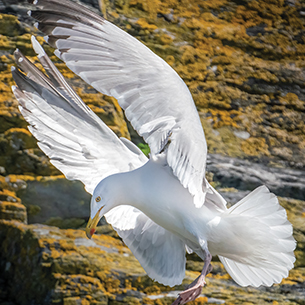


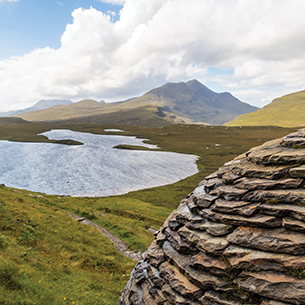
A Zodiac landing on the tiny island of Iona in the Inner Hebrides gives you a feel for how St. Columba arrived from Ireland in a small boat in 563 A.D. to found a monastery that became the cradle of a Celtic brand of Christianity. Monkish scholars produced works over the ensuing years, such as the illuminated Book of Kells, now prominently displayed at Trinity College in Dublin. Iona also may be the origin of the famous Celtic cross with a ring around the intersection and is the burial site for scores of early Scottish and Irish kings as well as a few from Norway, along with the more local rulers of the blue-painted Picts and the Dalriada.
One of the most influential islands in the area, visited via a Zodiac boat from the Seabourn Venture, is an uninhabited one. Staffa is home to Fingal’s Cave, a stunning natural structure of massive basalt columns with near-pilgrimage status that inspired Mendelssohn’s Hebrides classical music overture and is noted in popular literature, including Jules Verne’s Journey to the Center of the Earth. The name Fingal is likely a variant of Finn McCool (Fionn mac Cumhaill), a mythological Celtic hero who led a band of warriors called the Fianna (a name that appears in modern times in connection with the Fenians associated with Irish nationalism). Staffa, though, is well populated by a large colony of puffins nesting in their thousands and a bevy of playful seals that may recall the shape-changing selkies of Celtic legend that wed local fishermen.
The old Kingdom of the Isles still feels like it’s at the edge of the world, despite the modern trappings (and a distillery) of Tobermory on the island of Mull and windy Stornoway on the Isle of Lewis, most famous for a chess set left behind by Vikings and the warmth of its Harris Tweed clothing. By now, culturally acclimatized passengers are alighting ashore with a craving that can’t be alleviated aboard ship—that desperate look in the eye that says I could murder a scone! (Preferably with a cup of tea.) The weather in the Outer Hebrides is variable at best and as can happen at sea, planned Zodiac excursions to small islands called Lunga and Shiant are called off. They’re for the birds anyhow.
Sailing further north brings place names both Celtic and Viking in origin, testimony to the latter’s enduring influence throughout the region’s history. Ullapool is a charming village in the northwest Scottish Highlands named for its original Norse settlers that harbors a very active outdoors scene for hiking nearby mountains like Knockan Crag (nature.scot) or cycling around ancient Pictish forts. Legend says that Rome’s Ninth Legion, some 5,000 men strong, disappeared in these parts, then called Caledonia by Latin speakers. The second-century event is said to have had a direct bearing on the building of Hadrian’s Wall and the separation of England and Scotland ever since. It’s also been the subject of many films. The wild landscape blurs reality and imagination, and it doesn’t take much to hear a bagpipe on the wind.
One of the most influential islands in the area, visited via a Zodiac boat from the Seabourn Venture, is an uninhabited one. Staffa is home to Fingal’s Cave, a stunning natural structure of massive basalt columns with near-pilgrimage status that inspired Mendelssohn’s Hebrides classical music overture and is noted in popular literature, including Jules Verne’s Journey to the Center of the Earth. The name Fingal is likely a variant of Finn McCool (Fionn mac Cumhaill), a mythological Celtic hero who led a band of warriors called the Fianna (a name that appears in modern times in connection with the Fenians associated with Irish nationalism). Staffa, though, is well populated by a large colony of puffins nesting in their thousands and a bevy of playful seals that may recall the shape-changing selkies of Celtic legend that wed local fishermen.
The old Kingdom of the Isles still feels like it’s at the edge of the world, despite the modern trappings (and a distillery) of Tobermory on the island of Mull and windy Stornoway on the Isle of Lewis, most famous for a chess set left behind by Vikings and the warmth of its Harris Tweed clothing. By now, culturally acclimatized passengers are alighting ashore with a craving that can’t be alleviated aboard ship—that desperate look in the eye that says I could murder a scone! (Preferably with a cup of tea.) The weather in the Outer Hebrides is variable at best and as can happen at sea, planned Zodiac excursions to small islands called Lunga and Shiant are called off. They’re for the birds anyhow.
Sailing further north brings place names both Celtic and Viking in origin, testimony to the latter’s enduring influence throughout the region’s history. Ullapool is a charming village in the northwest Scottish Highlands named for its original Norse settlers that harbors a very active outdoors scene for hiking nearby mountains like Knockan Crag (nature.scot) or cycling around ancient Pictish forts. Legend says that Rome’s Ninth Legion, some 5,000 men strong, disappeared in these parts, then called Caledonia by Latin speakers. The second-century event is said to have had a direct bearing on the building of Hadrian’s Wall and the separation of England and Scotland ever since. It’s also been the subject of many films. The wild landscape blurs reality and imagination, and it doesn’t take much to hear a bagpipe on the wind.
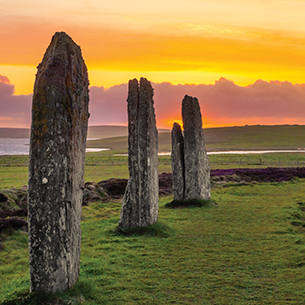
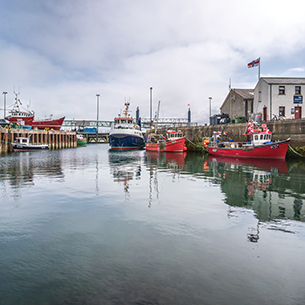
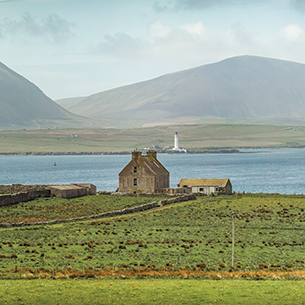
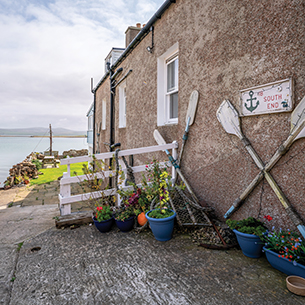
History becomes ethereal the farther north one travels. On the Orkney Islands, a walk around the giant standing stones of the Ring of Brodgar (historicenvironment.scot) is to experience a hint of old beliefs dating to the Neolithic period of around 2400 BC. Set in a natural amphitheater surrounded by low-lying hills and two bodies of water, the evocative Ring of Brodgar appears to be linked to similar sites in the Orkneys along astronomical lines, generating new interest in the once-fringe study of archaeoastronomy. Originally consisting of 60 stones, 36 still survive. Some scholars now think structures like the Ring of Brodgar (named for a local Viking settlement) on the Orkney Islands were the starting point for megalithic monuments like the more famous Stonehenge far to the south. An excavated village nearby called Skara Brae offers a thin sketch of who the builders might have been but falls shy of illuminating the overall mystery.
Meanwhile, Seabourn Venture has found its Celtic and social footing with an onboard pub night (that needs extended hours!) featuring local brews and spirits, musical talent from Dublin, and another evening focused on local Scottish cuisine (haggis not included). A voyage like this might be served well by an organized (call it educational) sampling of the many varieties of Irish and Scottish whiskies and the clear distinctions among them.
Aye then, sit and ponder over a dram what might have been if King Robert de Bruce had succeeded centuries ago in uniting Scotland and Ireland under one Celtic banner. “Yes I said yes I will Yes.” Homer’s got nothing on Joyce.
Photo Credits: Courtesy Seabourn/John Shedwick; Seabourn; AdobeStock
Meanwhile, Seabourn Venture has found its Celtic and social footing with an onboard pub night (that needs extended hours!) featuring local brews and spirits, musical talent from Dublin, and another evening focused on local Scottish cuisine (haggis not included). A voyage like this might be served well by an organized (call it educational) sampling of the many varieties of Irish and Scottish whiskies and the clear distinctions among them.
Aye then, sit and ponder over a dram what might have been if King Robert de Bruce had succeeded centuries ago in uniting Scotland and Ireland under one Celtic banner. “Yes I said yes I will Yes.” Homer’s got nothing on Joyce.
Photo Credits: Courtesy Seabourn/John Shedwick; Seabourn; AdobeStock




